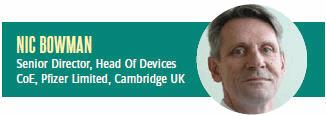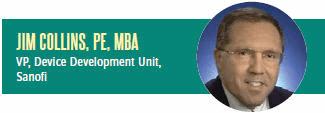Drug Delivery Devices Could Be A Big Winner In 2017
By Bob Marshal, Chief Editor, MedDeviceOnline.com
Where is the medical device industry headed, and what factors will shape it in 2017? First, we should not underestimate the macro-level effect the presidential election will have on policy and regulation in 2017. Since the day after the votes were tallied, many voices in and around the medical device community have been asking big questions. Will the Affordable Care Act be changed or eliminated? Will the medical device tax be repealed? Will there be more industry-friendly leadership at the FDA and CMS? The answers to these questions have huge potential impacts, but they will be realized only after the new administration is in place. Those answers will shape market size, the cost of doing business, speed to market, and the ability to get paid. With this uncertainty, what can we do? We can focus on things that are more predictable, at least to a panel of industry experts. We spoke with three professionals “in the know” to garner their insights on topics such as market drivers, positioning, and growth opportunities.

What market drivers will most influence drug delivery devices over the next two years?
Given the time frames for delivery, the launches over the next two years will have already been defined by now, or the underlying technology (if a platform device) will be predeveloped. Over a longer time frame, the market trends appear to be influenced by several factors, including improved usability, improved patient preference, reduced pain, and the potential for connectivity.
How should companies position themselves to address those issues?
A clear strategy should be defined for ongoing development. The strategy should be informed by knowledge of the competitive landscape, patient preferences, new technology available, the company portfolio, and the regulatory environment.
What types of devices/delivery platforms offer the most market growth opportunity?
Differentiation is required to enable patient preference to play a role in prescribing in a complex multiplayer market, which is increasingly becoming the norm. Adding device options to capture the broadest patient grouping is viable and has been demonstrated in the diabetes market, but not replicated in other therapeutic areas to the same degree.
Which therapeutic areas will lead to the most growth in delivery device?
Clearly, home-use chronic therapies are the main driver for delivery devices. The holistic cost benefit of self-medication with the home environment is a strong driver for many franchises. Although there are clear current leaders (diabetes, rheumatoid arthritis, MS), there is no overriding reason why other franchises should not migrate further into this space. There are already examples of switching intravenous to subcutaneous to enable more convenient delivery for the patient.
Pharma/bio companies have shifted their business model from acquiring a device to developing delivery devices in-house. What trends will emerge in purchasing, outsourcing, or partnering of devices, versus in-house design and development?
A number of development models still exist, ranging from fully outsourced to full internal development. All models have benefits and compromises. Of the 23 disposable auto-injectors launched since 2006, 20 were developed with external partners, so the evidence is that external partnerships still make up the most significant proportion of developments. Device companies are playing a strong role in development; their business models are now changing to include the development of fully tooled device options to enable very fast times to the clinic.
Do you anticipate a growth in the drug industry’s partnerships with consumer electronic and technology companies?
Connectivity is creating a growing “buzz” of interest and enthusiasm across the industry. Technologically, this is quite achievable, but no one has established a viable system that covers all the open questions. An industry consortium would be one way to potentially enable definition of an industry broad standard to allow development of systems that are suitable for all parties, including patient, pharma, payers, and healthcare professionals.
How will today’s empowered patient (aware, engaged, and making decisions) drive change in delivery device considerations?
The importance of the patient in the choice of therapy is becoming recognized. When a choice of delivery device is available within a therapeutic area, it is clear that the patient could have an influence on the brand that is prescribed. Hence, it is important to understand patient preference, and design your devices to suit.

What market drivers will most influence drug delivery devices over the next two years?
First, there is increasing competition from brands, biosimilars, and generics. This leads us to believe we’re going to see more insulin-like markets going forward. More and more, the administration experience is going to be a basis of competition. We’re even seeing oncology become relevant in this discussion. In the past, differentiating based on the administration experience in oncology would have been unheard of.
Another trend is going to be the more frequent use of specialty medicines in spaces that have been traditionally served by small molecules. We’re already seeing this in hypercholesterolemia, and we’re going to see an increase in specialty medicines in migraine and asthma and in other areas where we previously just had oral small molecule formulations.
That’s going to create a device dependency in these markets. It’s also going to introduce devices to patients who are pretty naïve when it comes to using such devices. And it’s going to make the demand for the user experience that much more complex.
When you reference “specialty medicines,” are you just talking about refinements or are you referring more to precision medicine?
It’s a little of both. I think it’s really about introducing protein therapy use. We’re going to see protein therapies entering areas where they haven’t played in the past. There’s going to be protein therapies, for example, in asthma beyond Xolair, and those therapies are going to be self-administered.
Will these changes bring a whole new set of problems as well?
Sure, there will be a lot of issues to work through regarding self-administration. Whenever you’re talking about self-administration, you have to discuss device simplicity and usability. You have to address these two issues if you want to broaden the range of applications.
After the fact, you’re going to see formulation work in tandem with devices to improve the user experience.
How should companies position themselves to address these issues?
It really depends on the company’s specific pipeline and the markets they’re focused on. We appreciate that some companies want to try to be “fast followers.” However, I don’t know how rational that point of view is considering the current standing of combination product legislation.
I understand that not everybody wants to be at the front line of innovation. I do think, though, that most companies need to seriously assess how they’re going to participate in delivery innovation going forward. Otherwise, they’re going to be left behind by companies that have already embraced it.
Biopharma is traditionally not very good at device design. At those companies that are innovating, the device groups need to take ownership over the historic disconnect between device engineering and commercial. They’ll need to bridge that gap and create a really tight coupling.
What types of devices/delivery platforms offer the most market growth opportunity?
There are exciting device platforms that are going to drive growth. This is certainly the case in wearables — wearable bolus injectors, wearable micro-infusers. Recently, Amgen launched one in the PCSK9 space with West Pharmaceuticals that was the first of its kind. We’ll continue to see wearables grow in importance as they become easier to use and more competitive with auto injectors — more set-and-forget — and potentially more comfortable for the user.
I also think with soft-mist inhalers and piezotype nebulizers, you’ll see a change in the classic metered-dose and dry-powder inhalers (MDI/DPIs). That’s not to say those are going away, but the softmist inhaler that’s out there now is an improvement over MDI/DPI. And I expect others to try to adopt similar platforms (e.g., integrating device with digital/connective technologies).
Is the soft-mist inhaler designed to allow other drugs to be delivered that way, or is it just a more comfortable, effective delivery method?
With the right development work, it may be able to do both. And I know that biopharma is looking for it to do both. One of the reasons is the issue with the lack of well-behaved antibodies. Both the piezo and the soft-mist have the potential to deliver protein therapies without destroying them. With the jet nebulizers, if you put anything in there, it just wipes it out. All you can put in there are the small molecule chemicals.
Also, if you look at it from the small molecule perspective, you really get better penetration into the lungs. With both types, there’s a lot less product left in the mouth and throat, and also it’s a more comfortable experience to get that soft mist than to get the blast from either a jet nebulizer or MDI/DPI.

What market drivers will most influence drug delivery devices over the next two years?
I see two elements that are going to be important. First is the role that connectivity could provide with integration into delivery devices to impact health outcomes.
Second is the role of the payer and payer access to healthcare formularies. With more biosimilar products — or therapeutically equivalent products — there’s a good opportunity for devices to differentiate, but there’s also the potential for a diminishing of the role of devices if the payers don’t make more than one device option available to the patient.
How should companies position themselves to address those issues?
In addition to patient-centered design, it will be important to have an element of what I’ll call payer-centered design. Patients don’t benefit unless they get access to the product. The roles that device product costs play and how the payers provide access are critical to understand in the design process.
Regarding connectivity, building out med tech capabilities, having the ability to integrate electronic and embedded software, as well as partnering with key external companies in this space will all be important going forward.
What types of devices or delivery platforms offer the most market growth opportunity?
If you look at the market data, large molecules today are delivered by the patient primarily in only four device types: auto-injectors, prefilled syringes, infusion systems, and pumps. Overall, the growth in auto-injectors is substantial, and we should anticipate it will continue, not only with monoclonal antibody delivery, but because more peptides and proteins are being engineered to be delivered weekly.
Then, what I see is that some aspect of largevolume injection, patch injectors, or body-worn injectors will emerge as an opportunity, because when you get above a certain milligram level, it is difficult to deliver in an auto-injector the total drug volume in the delivery time that regulatory authorities and patients are requiring.
For small molecules, pulmonary/respiratory and transdermal devices make up the lion’s share of the market. I expect those will continue to be the key areas to focus on and will provide the primary opportunities for growth.
Do you think in emerging markets it’ll be the same trends, or will there be different delivery mechanisms?
In emerging markets, cost is more of a factor. I think we could see prefilled syringes become a key mode of delivery in emerging markets. But the challenge for pharma companies — and I think this is a challenge that can be achieved — is getting the development and manufacturing costs of pens and auto-injectors down to where they can be made available for emerging markets on a broad scale.
Of course cost will continue to be a driver in established markets, too. We need to think about how to design lowcost solutions for emerging markets and actually apply them on more of a global basis.
What are some top challenges facing drug delivery device companies and professionals?
I haven’t talked much about patient-centered design because it’s now almost core to what everybody’s doing. But it still is key to the design process. You need to be patient-centered and really understand the difference between patients, because RA patients are different from those with diabetes, and so on. You also have to design the system, not just the device. The delivery system can only be optimized if the drug substance, formulation, primary container, and device components are all designed as a system to meet the patient’s needs.
We have to figure out how to engage R&D and others on the patient experience seven or eight years before the product’s going to market. That’s a challenge. How do you best teach a biopharma research organization that it is very important to be thinking about the patient administration experience from the very beginning if they really want to optimize the product.
Device leaders in biopharmaceutical companies have to realize that their job is to figure out how to make the process work end to end. You can’t just think that your device design role is to take the baton from point A to point B, because if you do, you’re never going to be successful. You have to try to influence and improve the entire device development system within your company end to end.
This doesn’t mean you have to own device manufacturing, marketing, or medical, but it means you have to be able to influence from discovery all the way through manufacturing and into the market. You need to work to educate everybody from medical to marketing to legal on what their role is to make a successful device, and to help them build business processes you need to successfully develop those delivery devices. If you don’t do that, it’s really hard to put yourself in a strong position to succeed.
